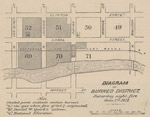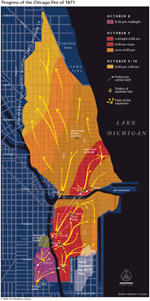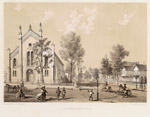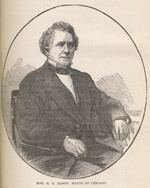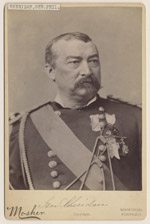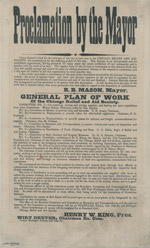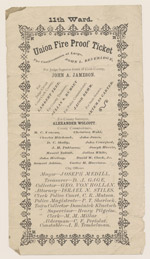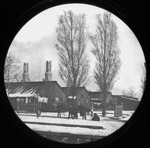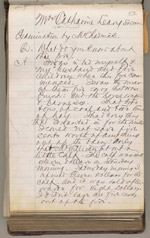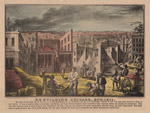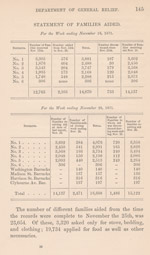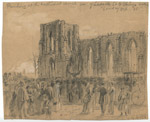North Division Improvements
Tuesday, January 3, 1871
At a meeting of residents of Chicago’s North Division and of the adjoining town of Lakeview, the Committee on Local Improvements and Abatement of Nuisances makes several recommendations. These include: removal of the graves in the former cemetery grounds near the lake above North Avenue and the integration of this area into Lincoln Park as quickly as possible, connection of the lake shore drive with Pine Street (now North Michigan Avenue), widening State Street from Chicago Avenue to at least Division Street, and construction of a viaduct over the railroad tracks just north of the Chicago River. The committee describes these tracks as “the most dangerous point in the city, wayfarers running the gauntlet of the [Clark Street] bridge only to run into the jaws of death.”
1871-01-03
Board of Health Mortality Report
Tuesday, January 10, 1871
The Board of Health issues its weekly mortality report. Ninety-six Chicagoans died in the reporting period, which is 6 fewer than in the same week a year earlier, and 5 fewer than in the preceding week. The deceased included 52 males and 44 females. Of these, 23 were under the age of one, which reflects the high infant mortality rate at the time. The leading killers are pneumonia (12), consumption (11), convulsions (9), and croup (7). The city health officer reports that in the last week he condemned 6 quarters of beef, 49 carcasses of mutton, 25 calves, and 3 hogs, most of these at a stock yard on Kinzie Street.
1871-01-10
Snow Halts the Streetcars
Wednesday, January 18, 1871
Local street car companies still struggle to recover from a heavy snow that fell five days earlier. The South Side Company has its State Street line open to 31stStreet, while its Cottage Grove Avenue route is open to 30th Street. Both the Indiana and Archer Avenue lines are still shut. The North Clark Street line is clear to North Avenue, but the Chicago Avenue and Division Street routes are still blocked. The worst problems are with the West Side lines: the Madison Street, Milwaukee Avenue, Blue Island Avenue, and Clinton Street lines all remain shut.
1871-01-18
Extending the Fire Watch
Tuesday, January 24, 1871
The Board of Police and Fire Commissioners, gathered at a special meeting, orders that from nightfall until 9:30 pm firemen will keep a lookout for fires from the watch-towers at their stations. This will supplement the regular night watch, which begins at 9:30.
1871-01-24
Intracity Train Speed Limits
Monday, January 30, 1871
With grade-level accidents a continuing major problem, the Common Council adopts a resolution that asks the Board of Police to enforce the ordinance restricting the speed of trains traveling within the city to six miles per hour.
1871-01-30
Chicagoans Root for France
Saturday, February 4, 1871
At a rally in Crosby’s Opera House under the auspices of the French Producers’ Association, Chicagoans gather for the purpose of aiding the people of France suffering from the ravages of the Franco-Prussian War. At the meeting, Chicago banker and leading citizen William F. Coolbaugh reminds listeners how during the American Revolution the French answered the patriots' call for help. “They responded promptly,” Coolbaugh declares, “they answered with money and with ships of war, and with thousands of strong hands and brave hearts; and, side by side with Washington and his gallant companions, they fought the battles of the Revolution and helped to achieve the independence of these United States of America.” His rousing address is greeted with applause. A fundraising concert held on February 24 draws an enthusiastic but small audience.
1871-02-04
The Lively Arts Defeat the Winter
Wednesday, February 8, 1871
Opera lovers brave a storm to pack a performance of Beethoven’s Fidelio. Meanwhile, the famed (and famously temperamental) Czech actress Fanny Janauschek wins raves for her lead role in Schiller’s Mary Stuart at McVicker’s Theatre, where she is also playing Lady Macbeth. Other highlights of the Chicago stage include The Trip Around the World, now in its fourth week at the Dearborn Theatre, which is reportedly a record run for a minstrel show in the city.
1871-02-08
Two Cheers for Social Purity
Thursday, February 16, 1871
Some forty women gather at an afternoon meeting of the Society for the Promotion of Social Purity. The Society’s goals are “to extend to the fallen a true sympathy; to ascertain, as far as possible, their present condition, and the causes which led to their fall, as well as the sources from which their support is derived; to give to the public information respecting the present condition of the evil; to disseminate scientific knowledge in regard to the relations of the sexes, and to urge the observance of physiological and moral law; to assist in creating and sustaining a pubic sentiment which shall demand of purity of life exactly equal to that which they require of their sisters and wives.” The meeting is adjourned when, because of a misunderstanding, the scheduled speaker, Boston-based reformer Bronson Alcott, fails to appear.
1871-02-16
Female Physicians
Thursday, February 23, 1871
Commencement exercises for the Woman’s Hospital and Medical College are held at the Clark Street Methodist Church. The three women in the graduating class receive their M.D. diplomas from trustee Erastus O. Haven, President of Northwestern University. Haven explains that the Woman’s Hospital and Medical College was organized when the Chicago Medical College refused to admit women. “Any human being has a native right to all the pure knowledge that he or she may desire and is able to acquire,” he declares. “There are women who desire to study medicine. To forbid them would be an impertinence and a tyranny. To aid them would be reasonable and right.” Haven closes with an appeal for financial contributions.
1871-02-23
Establishing the Parks
Thursday, March 2, 1871
The Board of West Side Park Commissioners (there are equivalent boards for the South Side and for Lincoln Park) holds its second annual meeting. Board President George W. Stanford presents the annual report, calling for an open-ended commitment to investment in the emerging park system. He offers a practical argument and a criticism of Chicago's development to date. “In the past,” he states, “we find no precedent where, in any large city, this kind of improvement has proven otherwise than profitable to the tax-payer.” Stanford continues: “It is a notorious fact, with regard to Chicago, that heretofore, with all its business and commercial advantages, it has afforded no sufficient attraction or inducement to bring hither, or keep within its borders, that large and valuable class of inhabitants who seek pleasant homes, within which to spend well-earned fortunes.”
1871-03-02
Betting and Billiards
Saturday, March 11, 1871
Eight hundred spectators attend the evening billiards match between Frank Parker and John W. Coon at the downtown Music Hall. Billiards is a very popular sport at this time, one that attracts a lot of betting. The odds are virtually even—while many think Parker the best match player in the country, Coon seems to be at the top of his game. The lead changes hands several times before the left-handed Coon takes control and triumphs by eighty points.
1871-03-11
A Great Day for the Irish
Friday, March 17, 1871
Chicago celebrates St. Patrick’s Day. The marchers lining up along Michigan Avenue stretch from Van Buren to Sixteenth Street. Crowds of onlookers watch the parade pass, and everyone is wearing at least a touch of green. That evening the Irish Literary Society hosts a banquet and ball at the Briggs House hotel, where the program includes music, recitations, and toasts. In his speech, J. J. Fitzgibbon states that the highest purpose of the day is “to declare our unchanging devotion to the principle of Irish nationality.”
1871-03-17
Lincoln and Chicago History
Tuesday, March 21, 1871
The Chicago Historical Society holds its regular quarterly meeting. Attorney Isaac N. Arnold reads a letter from sculptor Leonard W. Volk, currently in Rome, whom the Society has commissioned to carve a marble bust of Abraham Lincoln. The late president sat for Volk in Chicago during April of 1860, a few months before he was elected. Volk claims that he sensed at the time that Lincoln would soon be leader of the nation, and, with that in mind, “was desirous of making a faithful representation of him, without a wish to flatter his remarkably rugged and striking features, but make him just as he was, so that posterity might look at [the bust] and know it as a veritable and faithful likeness.”
1871-03-21
The Common Council Gets It Done
Monday, March 27, 1871
The Chicago Common Council accomplishes a great deal of business. Agenda items include multiple requests, among them one to open Milwaukee Avenue from Lake to Desplaines Streets, and another to enforce the ordinance against horse jockeying and Sabbath breaking. In addition, it receives a report from the Board of Health recommending that the council provide residents with public baths, and a proposal from the Board of Police and Fire Commissioners that the city replace crank-powered fire alarms with ones that do not require this effort.
1871-03-27
The Board of Trade Boosts Chicago
Monday, April 3, 1871
At its twenty-third annual meeting and election of officers, the Board of Trade chooses J. W. Preston as its president. The Board reflects on the past year's business and on current economic conditions. “The general trade of our city, especially in cereals, has been more than usually prosperous,” the directors state, “and, while the receipts of corn, owing to the very light crop of 1869, were below the range of the years in the recent past, still our pre-eminence as a grain market has been maintained, and, perhaps, in no year since the close of the war have our prices ruled more steady, or with less violent fluctuations. The last harvested crops in the territory tributary to Chicago were of unusually fine quality, and we have to congratulate ourselves that Chicago grain now ranks with the best in all markets.” Regarding the provision trade, the directors add, “Chicago has, within comparatively few years, advanced to the first position in the country or the world, our packing of hogs, during the past fall and winter, aggregating 918,000 head.”
1871-04-03
Higher Education for Women
Sunday, April 9, 1871
Evanston’s First Congregational Church is the site of a discussion of the establishment in Evanston of a new college for the education of women. Frances Willard, who has been elected president of that college, is the main speaker. Her topic is “People Out of Whom More Might Have Been Made.” Willard explains that she has long been inspired by Margaret Fuller Ossoli’s declaration on behalf of women, “Our only object in the world is to grow.” Willard maintains that women should pursue higher education. She asks her audience for three things: their confidence, their daughters, and their contributions.” The Chicago fire will make it impossible to raise the funds necessary for an independent college for women, but one will be created in association with Northwestern University.
1871-04-09
Fire Figures
Tuesday, April 11, 1871
City Fire Marshal Robert A. Williams submits his annual report. The number of fires in the past year exceeds that of any previous year since the formation of the paid department in 1858. Well over 600 fires have destroyed almost $2,500,000 in property, an increase of more than $1,500,000 over the previous twelve months. The biggest blaze, which burned the Drake, Farwell, and Thatcher Block (on Washington Street east of State Street) the past September, incurred damages of over $1,300,000 and claimed five lives. In his review of the department’s equipment, Williams states that the oldest engine has been in service for ten years. Since the last report the department has purchased 10,500 feet of hose and added 16 horses (for a total of 88). By far the largest cause of fire has been carelessness, with defective chimneys and suspected arson following far behind.
1871-04-11
The Drop of a Bad Hat
Wednesday, April 19, 1871
While the driver of a horse and buggy is making a call at the corner of Washington and Ann (now Racine) streets in the West Division, a thief steals his rig. It is recovered within fifteen minutes. It turns out that the horse was too much for the robber to handle; it threw him out of the buggy at Halsted and Milwaukee. When a policeman, unaware that he is witness to a crime, comes to the aid of the thief, the latter makes a break for it in so much haste that he loses his hat.
1871-04-19
From Beethoven to Bolero
Wednesday, April 26, 1871
Maestro Theodore Thomas leads his orchestra before a filled Farwell Hall in the third of a series of concerts. The program includes the Overture to Mozart’s Don Juan, a scherzo from Mendelssohn’s Reformation Symphony, the first part of Beethoven’s Concerto in G, No. 4, a polka and waltz by Straus, and a Berlioz march, as well as a bolero by a Chicago composer.
1871-04-26
Of Time and the River
Wednesday, May 3, 1871
In a development that has become commonplace, boat captains on the Chicago River ignore the local ordinance that limits daytime bridge openings to twenty minutes, causing simultaneous extensive delays for those hoping to cross the pivoting swing bridges at Adams, Madison, and Van Buren streets.
1871-05-03
Going Small
Friday, May 12, 1871
The Chicago Microscopial Society gathers for its semi-monthly meeting in the Academy of Sciences. The members spend the evening viewing specimens that they have recently acquired, including rare species of “animaculae” (the name given at the time to tiny organisms not visible to the naked eye) found in Lincoln Park, an unidentified beetle discovered in a spider web in a local garden, and a small creature that looks to these Chicago gentlemen of education, means, and ethnic prejudices “like a squelched emigrant from Ireland.”
1871-05-12
Strawberries and Sympathy
Tuesday, May 16, 1871
It is the season of strawberry festivals that raise money for charity. They begin this evening with festivals hosted by the women of several churches. Tomorrow is the turn of the ladies of Trinity Episcopal Church, who will host their festival at Pennoyer & Company’s new carriage warehouse on the corner of Wabash Avenue and Congress Street. They hope to use the proceeds to fund a mission. The same evening another fete takes place at Martine’s North Side Hall on Ohio Street. Its goal is to build a parsonage for the Church of the Ascension. On Wednesday, Thursday, and Friday of this week, the Ladies Christian Union receives guests at its strawberry dinners in Metropolitan Hall, on the northwest corner of Randolph and LaSalle streets.
1871-05-16
The Once and Future Horners
Wednesday, May 17, 1871
Miss Delah Horner, daughter of merchant Henry Horner, weds Mr. Solomon Abraham Levy of Cincinnati at KAM Synagogue, which since 1865 has occupied a former church at Wabash Avenue and Peck Court (now Eighth Street). The bride wears white satin, the bridesmaids white muslin with pink trimmings. The reception follows immediately at the Standard Club, on the corner of 15th Street and Michigan Avenue. The marriage will unfortunately end in divorce, but the couple’s son Henry, born in 1878, will take his mother’s last name and will become an attorney and then a judge before being elected Illinois’s first Jewish governor in 1932.
1871-05-17
Chicagoans Root for Germany
Monday, May 29, 1871
Rain dampens but does not discourage the throngs of Chicagoans of German birth and ancestry who travel in carriages and wagons, on horseback and on foot, to Wright's Grove, the popular picnic ground north of the city limits. They celebrate their pride in the recent unification of the German nation and Germany's military victory over France. The official program begins with medley of patriotic melodies and other compositions by German composers, followed by speeches. Franz Arnold’s oration praises German history, culture, and prospects to the skies while denigrating everything that is French. He also pays tribute to America on this Decoration Day. “In looking upon these thousands of German faces before me,” he states, “it is a pleasing thought to know that, when it becomes necessary for Germans to secure a recognition for the land of their birth in the land of their adoption, they can co-operate to this end without distinction of party.”
1871-05-29
A Brotherhood of Bricks
Saturday, June 3, 1871
The Brick Manufacturers’ Association elects R. P. Dencker to the presidency of the organization. Its goals are to “cultivate a more intimate and friendly relation among the fraternity [of brick makers], consultation with reference to the best interests of the business, and, as far as possible, the maintenance of uniform prices for brick, labor &c., thus preventing violent fluctuations that frequently occur, and prove disastrous to the business.”
1871-06-03
The "Great Unknown" Lights Up the Stage
Saturday, June 10, 1871
In what the Chicago Tribune calls “the richest dramatic treat of this season, or of any season,” African American actor William M. Johnson, who is billed as “the Great Unknown,” gives his last performance of reading from Shakespeare at the St. James Hotel, under the auspices of the Dramatic Glee Club. Johnson, the paper contends, “is certainly one of the most dazzling meteors that have yet shot athwart our dramatic horizon.” He outshines such famous leading men as Edwin Booth and Edwin Forrest, thanks to “an undefinable something which stamps him as a genius far removed from them all.”
1871-06-10
Death Assumes an Alias
Monday, June 19, 1871
Twenty-year-old Louis Kossuth Fergus dies of his wounds at about 5 a.m. in the Webster Avenue police station. The previous afternoon a professional thief supposedly named Wilson attempted to pick the pocket of a woman in Lincoln Park. Apprehended by Office John Mahr, Wilson appeared to submit quietly, but while being taken to the station he broke free, drew a revolver, and fired at Mahr, wounding him. Bystander Charles Hoffman tried to assist Mahr by grabbing Wilson, who wounded him as well. Mahr then took out his own weapon and fired back at Wilson, who shouted in anguish, “Damn your soul, you’ve fixed me,” and fell to the ground, where Hoffman held him down. That evening a detective from the Madison Street station identifies Wilson as being in fact Louis Kossuth Fergus. The coroner’s jury exonerates Mahr, commending him “for his forbearance on the occasion, and for the efficient manner in which he performed his duty as a police officer.” It also thanks Hoffman for his bravery and, noting that he is a poor man, recommends that the Common Council provide some sorely needed funds for Hoffman and his family while he is mending.
1871-06-19
Degrees and Disbursements at Northwestern
Tuesday, June 27, 1871
The trustees of Northwestern University hold their twentieth annual meeting in University Hall. The meeting is called to order by Dr. John Evans, chair of the university's board of trustees and the person after whom Evanston is named. On the recommendation of the faculty, the trustees confer one doctor of divinity, three master of arts, three bachelor of philosophy, and twelve bachelor of arts degrees. They also award two individuals honorary master of arts degrees, and they name Lieutenant General Philip H. Sheridan an honorary doctor of laws. They report that in the past year disbursements of $33,700 have resulted in a $6,500 deficit, but that the university still has almost $10,000 at hand. The committee responsible for finances recommends that the institution charge $10 a term for tuition and $5 for incidental expenses, but that university officers have the discretion to remit either all or part of the tuition charges for the children of ministers. The trustees approve the tuition proposal, as well as a resolution that expenditures be kept within net revenue.
1871-06-27
Independence Day
Tuesday, July 4, 1871
Plans have been announced for today's Fourth of July observances. The feature horse race at the Dexter Park track, located in the southwest corner of Chicago, will match James Van Etta’s Lady Douglas against Henry Graves’s Chicago, for a purse of $5,000; Wright’s Grove will witness a sham fight, a baby show, a fat man’s race, fireworks, dancing, a torchlight procession, and a speech by attorney, politician, and former Lincoln adviser Norman P. Judd; and the White Stockings professional baseball team will play the Rockford Forest Citys. In downtown Chicago, the city's worthies will ride in a procession of carriages up LaSalle Street and through the new tunnel beneath the Main Branch of the Chicago River as part of the ceremonies marking the inauguration of this structure, which is intended to avert delays caused by bridge openings.
1871-07-04
The Deep Cut
Saturday, July 15, 1871
The ringing of the bell in the cupola of the Court House proclaims that the gates have been opened and that the putrid waters of the South Branch of the Chicago River will now, it is hoped, flow south into the newly deepened Illinois and Michigan Canal, rather than north and east into Lake Michigan, the source of the city's drinking water. Another aim of the so-called "deep cut” is to increase traffic on (and revenue from) the canal, helping offset the cost of the project. On July 25 1,500 people will attend the ceremonies by the Main Branch of the river at State Street that mark the completion of the deep cut. The project will prove of limited effectiveness, however, and the river will remain a serious hazard until the construction of the Sanitary and Ship Canal in the last decade of the century.
1871-07-15
Picnic
Thursday, July 20, 1871
Many organizations embrace the summer with picnics. The Nineteenth Illinois Volunteer Infantry Association, whose members have a record of distinguished service during the Civil War, pitches its picnic tents in Des Plaines. Some attend in uniform, and reminders of the recent conflict include veterans with empty sleeves and wooden legs. The only battles of the happy day, however, are those among baseball teams representing the Post Office, the Mulligan Zouaves, and the Irish Rifles.
1871-07-21
Better with Bessemer
Friday, July 28, 1871
A group of about forty businessmen visit the Union Rolling Mill Company works on the South Branch of the Chicago River. Their purpose is to witness the new Bessemer process of making steel, which promises expanded production capacity. They arrive by a special train, which is delayed at the Burlington Crossing. They spend two hours at the mill and are favorably impressed by what they see. Union Rolling, which has invested $300,000 in this new technology, is the only facility west of Cleveland where steel is made by the Bessemer method. Following the demonstration, the visitors return to their train, where luncheon is served.
1871-07-28
Steaming to the Crib
Wednesday, August 2, 1871
The steam-driven pleasure boat Chicago Belle, 183 feet long and powered by two large engines manufactured in the city, takes three hundred invited passengers, including many leading citizens, on a free excursion to the Crib, the waterworks intake that is two miles out from the Lake Michigan shore at Chicago Avenue. Providing entertainment on board is the Great Western Band, and the guests are also treated to a demonstration of a newly-patented life-preserver, which is fortunately not needed.
1871-08-02
Circus by the Lake
Monday, August 7, 1871
Thousands of residents flock to the lakefront at Randolph Street to enjoy the famed Old John Robinson’s Circus, Menagerie, Museum, and Caravan, which fills three large tents. A fifty-cent ticket (half price for children) gains admission to the menagerie (whose animals are displayed in twenty-five gold and crimson cages), the museum, and circus. Doors open at 6 tonight, with afternoon matinees as well as evening performances the rest of the week. Among the top attractions are champion horseman Robert Stickney, child equestrienne Minnie Marks, and hurdle-rider Lewis Willis, not to mention Old Emperor the elephant, Billy the trained seal, and Conrad’s comical monkeys, as well as mammoth sea lions, monster camels, trained ponies, and educated dogs.
1871-08-07
A Cornerstone of Healing
Sunday, August 20, 1871
The cornerstone is laid for the new St. Joseph’s Hospital at Behring and Sophia (now Burling and Dickens) streets. The institution began in 1868 when Bishop James Duggan invited the Daughters of Charity, based in Maryland, to come to Chicago to tend to victims of cholera. The Daughters of Charity opened what was then called Providence Hospital in a two-story cottage at the corner of Clark Street and Diversey Avenue, which at that time was a quarter-mile north of the city limits. That building, situated just beyond the burnt district, will shelter refugees from the great fire.
1871-08-20
Filling the Faculty
Thursday, August 31, 1871
The Chicago Board of Education meets. After paying tribute to a recently deceased member, calling for a monthly report on the amount and quality of the coal purchased by each school, tabling a request from singing teachers that they receive the same pay as the principals of the grammar schools, deciding on the evaluation of the qualifications of janitors, granting certificates, and other business, the board tries to choose a teacher of French for the high school. After the first ballot proves indecisive, the matter is referred back to committee, with instructions to examine the candidates with the assistance of three French scholars. Other instructional selections prove easier. The board appoints Miss Grace C. Bibb and Professor M. Delafontaine teachers of Latin and Natural Sciences, respectively.
1871-08-31
Fall Colors
Sunday, September 3, 1871
A long article on fashion in the daily press announces that dark colors are the dominant hue of the current season, the favorites being shades of gray and violet, while those aspiring to sophistication will be dressed in—what else?—black. The fabric of the moment is barege (a sheer weave of silk and cotton or wool), especially if it comes in either black or grenadine.
1871-09-03
Going Green
Saturday, September 9, 1871
The Board of South Park Commissioners convenes in its rooms on LaSalle Street. On the agenda are the expansion and improvement of the land for what would become Washington and Jackson parks. Chief Engineer George W. White advises cutting a drainage ditch into the future Washington Park that will connect with ditches in the town of Hyde Park that run into the Calumet River and Lake Michigan. At their meeting the previous Thursday the West Park Commissioners adopt a resolution creating a committee of three to confer with the South Park Commissioners on where to locate the boulevard that will link their two systems. The West Park Commissioners also learn that in the previous month over $5,000 apiece was spent to develop Humboldt, Central (now Garfield), and Douglas parks, and that substantial contracts are out for additional trees and shrubbery. The board empowers its president to issue certificates of indebtedness to property owners who have spent their own money to landscape boulevards near their homes.
1871-09-09
Few Pearls Before Many Swine
Wednesday, September 20, 1871
Attendance is disappointingly thin on this the second day of the Illinois Swine Breeders’ Association Exposition at the Dexter Park race track. There are some 5,000 thoroughbred hogs on show. The most popular breeds are Berkshires, Poland Chinas, and White Chesters, as well as such hybrids as Lancashires and Cheshires. The pens were built under the supervision of John B. Sherman, one of the founders of the Union Stock Yard. Attendance improves the next day, rising to six or seven thousand, but it is still well below estimates. Among the notables present are General Joseph Hooker and Senator John Logan, after whom Logan Square will be named.
1871-09-20
Moral and Immoral Chicago
Monday, September 25, 1871
Author, reformer, and spiritualist Addie Ballou lectures on “Moral Chicago” in Farwell Hall. She does not draw nearly as well as did Horace Greeley the week before. Ms. Ballou contends that Chicago’s moral growth is keeping pace with its demographic expansion, as indicated by the number of churches and similar agencies of good and in spite of the fact that there are by her count some 1,800 saloons in the city. She will speak the next evening on “Immoral Chicago.”
1871-09-25
Chicago Hosts Cincinnati
Friday, September 29, 1871
The meeting of the Chicago Common Council opens with Council President Charles C. P. Holden welcoming a delegation of Cincinnati aldermen, who are in town on an informational tour that will next take them to St. Louis. Among its other business, the council refers to committee a recommendation that Z. R. Brockway of Detroit be appointed superintendent of the new bridewell, the prison for those who have committed minor offenses, at 26th Street and California Avenue. The proposed salary for Brockway is $8,000 a year.
1871-09-29
Whiskey to Burn
Saturday, September 30, 1871
The month ends with a large fire that consumes the Burlington Warehouse near the corner of State and Sixteenth streets, destroying an estimated $650,000 worth of property in about ninety minutes. The warehouse is owned by Samuel Nickerson, President of the First National Bank, who has leased it out. Lost inventory includes whiskey, wine, syrups, barrels, sugar, groceries, stoves, and machinery. Insurance on the building and its contents is held with more than sixty companies. The fire attracts thousands of gawkers. After it is put out, workmen find the body of Charles Stearns amid the ashes. The coroner’s jury rules that the managers of the warehouse followed proper safety rules and are not legally responsible for Stearns’s death.
1871-09-30
A Fiery Prelude
Saturday, October 7, 1871
A week of several small fires appears to climax with what would become known as the Saturday Night Fire. It begins late in the evening and soon devastates twenty buildings on the city’s Near West Side, leveling the area bounded by the South Branch of the Chicago River and Van Buren, Clinton, and Adams streets. Damage is estimated at a million dollars. In a grim rehearsal for the far larger catastrophe the following evening, a southwest wind fans the flames, blowing embers toward the center of the city. The fire will not be put out until the following afternoon, leaving firemen exhausted and their equipment in need of repair.
1871-10-07
The Great Conflagration
Sunday, October 8, 1871
At about nine in the evening, the Great Chicago Fire begins in or near the barn behind the cottage of Patrick and Catherine O’Leary, on the north side of DeKoven Street between Jefferson and Clinton streets. It will burn all through the next day and into Tuesday morning, destroying the commercial center of the city and most of the North Division.
1871-10-08
First Response
Monday, October 9, 1871
With the fire still blazing and the city in havoc, Common Council President Charles C. P. Holden assembles what city leaders he can in the safety of the First Congregational Church in the West Division’s tenth ward, which he represents. Mayor Roswell B. Mason arrives and soon issues a proclamation outlining numerous emergency measures. Other notices suspend the sale of alcohol and instruct the homeless that shelter can be found in schools and churches. General Philip Sheridan, who commands the United States Army Division of the Missouri from headquarters in Chicago, requisitions troops and supplies from posts in Nebraska, Missouri, and Indiana.
1871-10-09
Proclamations
Tuesday, October 10, 1871
With the fire now finally out, Mayor Mason issues a proclamation advising caution, calling for volunteers to serve as special police, asking citizens to organize local watches, indicating where food is available, closing saloons at 9 p.m., setting the price of bread, and ordering hackmen, expressmen, draymen, and teamsters to charge no more than normal fares or risk the loss of their licenses. Already citizens are patrolling the South and West divisions. The vault in the West Wing of the Court House is found intact, and some papers within it are recovered, but most city records are lost.
1871-10-10
Calling in the Troops
Wednesday, October 11, 1871
Mayor Roswell Mason states that the distribution of relief will be the responsibility of a Special Relief Committee, with headquarters in the temporary city hall that has been set up in the First Congregational Church. This committee will also issue free railroad passes for those wishing to leave the city. Mason issues instructions on how the efforts of the regular police, the special police, and the federal troops now in the city will be coordinated. The police are to act “in conjunction with General Sheridan, to whom Mason officially (if not entirely legally) entrusts overall responsibility for the “preservation and good order and peace of the city.” A number of leading bankers meet at the home of C. T. Wheeler and choose William F. Coolbaugh as their chair. He calls for the adoption of a plan to provide relief to the business community and reaffirms the commercial eminence and prospects of Chicago in spite of the catastrophe. South Division businessmen hold a similar meeting.
1871-10-11
"Calm, Quiet, and Well-Disposed"
Thursday, October 12, 1871
The mayor, city comptroller, city treasurer, and other officials move into a building at the corner of Hubbard Court (now Balbo Street) and Wabash Avenue. General Sheridan reports that all is well, and that “the people of the city are calm, quiet, and well-disposed.” Residents looking for relatives and friends continue to file through the temporary morgue that has been set up in a livery stable on Milwaukee Avenue. Among the dead are seventy bodies burned beyond recognition.
1871-10-12
Relief and Aid
Friday, October 13, 1871
Mayor Mason places the Chicago Relief and Aid Society in charge of the relief efforts, and the Society issues its general plan of work. It sets up committees on shelter, employment, transportation, reception and correspondence, health and sanitation, and on receiving, administering, and distributing supplies, as well as an overall executive committee chaired by corporate attorney Wirt Dexter. The city’s merchants organize for recovery, selecting Charles B. Farwell as their chair.
1871-10-13
Restoring a Lifeline
Sunday, October 15, 1871
Some three hundred machinists are working day and night to restore water to residents. The hope is to return the main engine to service by the middle of the week. In the meantime, railway locomotives and steam fire engines are pumping Chicago River water into mains. This involves real risks, given that the river is badly polluted. The city is also tapping into artesian wells in Lincoln Park and at the Northwestern Distillery.
1871-10-15
Money and Water Start to Flow
Tuesday, October 17, 1871
General Sheridan assures Mayor Mason that rumors of arson, shootings, and vigilante lynchings are without basis. The troops and the volunteers will continue to patrol Chicago for another week. The national banks in the city have now re-opened for business. Recent rains have lowered anxieties about additional fires. The Board of Health bans the use of water closets until water service is restored. The repaired engines in the waterworks on Chicago Avenue start operating in the evening, and water is flowing to the South Division the next day. Pressure will become uneven as the Board of Public Works tries to extend service, and there are complaints about non-essential use of water creating shortages for vital purposes. In the absence of gas, people are resorting to candles and kerosene. The Board of Education meets and resolves to open the public schools, to whatever extent possible, the coming Monday.
1871-10-18
Catherine O'Leary Defends Herself
Wednesday, October 18, 1871
A reporter pays a visit to Catherine O’Leary at her home on DeKoven Street. Although her barn is gone, her cottage is not harmed. She denies all the details of the story that one of her cows started the fire by kicking over a kerosene lamp. She says she never entered the barn that fateful evening and that she was in bed when the fire began.
1871-10-18
Economy and Real Estate
Thursday, October 19, 1871
Mayor Mason discharges all city employees whose services are not absolutely needed, advising department heads to observe “the most rigid economy.” John M. Van Osdel, the architect of many major pre-fire buildings, moves into an office in Nixon Block on the northeast corner of Monroe and LaSalle. This building, which is still not quite finished, is virtually the only structure in the burnt district of the downtown that made it through the fire. The first major post-fire real estate transaction takes place amid the ruins of the Fidelity Safe Depository, across the street from the Court House. H. W. Hinsdale sells T. B. Bryan a corner lot at Randolph and Dearborn streets for $50,000. Its estimated value just before the fire was $10,000 higher. Meanwhile, Potter Palmer, Cyrus McCormick, Farwell & Company, and others announce that they will rebuild their businesses right away. Col. J. H. Wood, who has lost his museum and theater on the north side of Randolph Street just east of Clark, takes over the Globe Theatre on Desplaines Street in the West Division. The only article he has salvaged from his museum’s immense collection of natural specimens and oddities of all kinds is the silver-coated revolver used by the notorious Mollie Trussell in June of 1870 to murder her lover in a Randolph Street saloon.
1871-10-19
Humiliation and Prayer
Friday, October 20, 1871
Mayor Mason “earnestly recommends” that Chicagoans observe Sunday, October 29, “as a special day of humiliation and prayer; of humiliation for those past offenses against Almighty God, to which these severe afflictions were doubtless intended to lead our minds; of prayer for the relief and comfort of the suffering thousands in our midst; for the restoration of material prosperity, especially for our lasting improvements as people in reverence and obedience to God.”
1871-10-20
A Cry from the Small Fry
Wednesday, October 25, 1871
Owners of small businesses—those with capital of less than $5,000—who have lost everything to the fire assemble in Court House Square to make public their need for help and their desire for a fair share of the relief funds. Speaking to another matter, the Relief and Aid Society claims that all those who need lodgings now have them, most having found shelter with their relatives and friends. The Society also states that it has erected barracks for the burnt out poor in Washington Square Park. All those who wish to work will be given employment, the Society says, but vagabonds will not be tolerated. Working class Chicagoans who own land but have no money to pay for a new house are being given materials with which to erect a modest home for the winter.
1871-10-25
Of Politics, Insurance, and Baseball
Tuesday, October 31, 1871
Candidates representing the newly-created Union Fire Proof ticket, which comprises Republicans and Democrats dedicated to restoring Chicago’s economy and reforming its politics, gather with their supporters at Haas & Powell’s Hall on Madison Street near Canal Street. Elsewhere in the city, a meeting is held to discuss receivership for insurance companies ruined by the fire. The previous day the Philadelphia Athletics defeat the Chicago White Stockings 4-1 in what proves to be the deciding game of the baseball championship of America, a kind of round-robin tournament involving several teams. These teams play each other at the Union Grounds in the Williamsburg section of the city of Brooklyn. The White Stockings wear a variety of ill-fitting uniforms they have borrowed from other teams since their own uniforms were among the casualties of the fire.
1871-10-31
Mayor Medill Speaks
Tuesday, November 7, 1871
The Union Fire Proof ticket dominates the city election. Joseph Medill is elected mayor in a landslide, and other nominees on the ticket capture fourteen of the twenty seats on the Common Council. In his victory speech, Medill tells the voters, “Your duty as electors has been performed independently and well, and Chicago has shown the world that she was worthy of the confidence reposed in her.”
1871-11-07
Shelter Housing and Fire Limits
Friday, November 10, 1871
The Relief and Aid Society’s Shelter Committee reports that it has received to date 6,259 applications for shelter houses and has approved the construction of 4,564 of them. In order to guard against the spread of smallpox, it has administered 1,300 vaccinations to residents of the barracks. The Board of Public Works’ review of fire damages indicates that over 121 miles of sidewalks were lost out of a pre-fire total of 680 miles, at a cost of $911,380.90. The Common Council’s special committee on fire limits is hard at work on new regulations. There are many calls to make the limits broad and stringent, but meanwhile people are erecting wooden structures in the burnt district.
1871-11-10
The Cost of Safety
Thursday, November 16, 1871
The Common Council’s special committee considering new fire safety regulations proposes a virtual ban on wooden houses, as well as very high standards for those made of brick. By the terms of this proposal, walls of one-story brick houses must be at least twelve inches thick, and taller homes must have even thicker walls in their lower stories. All roofs are to be made of metal, slate, terracotta, or another fireproof material, and any cornices, coping, bay windows, or other projections must be similarly non-flammable. The proposal immediately draws criticism not only from working-class residents who cannot afford such buildings, but also from those in the real estate business who say it will drive up prices.
1871-11-16
Young Men at Loose Ends
Friday, November 17, 1871
Members of the Young Men’s Christian Association of Trinity Church, which was destroyed by the fire, express their concern that one of the unfortunate results of the conflagration is that there are now many promising men of intelligence and respectability at loose ends in the city, with neither a home nor a job. Many more are now working at a reduced salary and are forced to live in grim rented rooms. This makes the temptations of the city’s saloons, billiard halls, and cheap theaters all the more powerful, with personal ruin being the likely outcome. With this in mind, the group plans to open a free Young Men’s Club and Reading Room, comfortably furnished and well stocked with respectable reading matter, chess boards, and stationery, which will provide an appealing place of pleasant social intercourse and mental improvement. The Association solicits the public for contributions to support this worthy effort.
1871-11-17
The Fire Inquiry
Friday, November 24, 1871
The Board of Police and Fire Commissioners, on the second day of its inquiry into the causes of the fire, hears testimony from Catherine O’Leary. She states, as she has previously, that she, her husband Patrick, and their five children were all in bed when the fire started, and that they knew nothing about it until their neighbor, Daniel Sullivan, aroused them with the news that their barn was ablaze. While she cannot corroborate the story herself, she says she heard that the McLaughlins, who rent the front section of the O’Leary double cottage, were holding a party that evening and that one of the revelers had gone out to the barn to get milk to use in preparing an oyster dish.
1871-11-24
The Downtown Revives
Saturday, November 25, 1871
An account of the progress of the resurrection of the commercial downtown lists the many brick and stone structures that are already built or in progress. It states that of 212 buildings, 112 are located on Madison, Monroe, Clark, State, and Wabash, while about 100 are equally scattered on other streets. It predicts (wrongly) that Wabash between Washington and 22nd streets will now displace the blocks around State and Madison streets as the city’s prime retail district. In a related development, so much rubble from the fire has been dumped in the lake between the Illinois Central tracks and the shore that this man-made basin has virtually disappeared.
1871-11-25
The Relief and Aid Society Offers an Interim Report
Wednesday, November 29, 1871
The Relief and Aid Society releases more figures on its work. During the week ending November 25, it assisted 3,356 families, and the total number of families it has aided since the second week of October is 15,152. There are currently 790 families in the barracks the Society has constructed in various parts of the city. The day before the Relief and Aid Society report is presented, the Board of Health states that it has been monitoring living conditions in these barracks very carefully. It continues to be especially vigilant about communicable disease, with typhoid being the particular current concern.
1871-11-29
Seeking Amusement
Friday, December 1, 1871
Chicagoans, who at first stayed away from what theaters were open in the weeks after the fire, are now finding such amusements a welcome distraction. They attend Progress at the Michigan Avenue Theatre, and a minstrel show at the West Side Opera House. Divorce continues to fill seats at the Globe, though it will soon be succeeded by Bertha; or, The Fate of the Sewing-Machine Girl. There will be a program of music at the Turner Hall on West Twelfth Street on Sunday. The managers of the Star Lecture Course, which brings well-known speakers to Chicago—recent visitors include Edward Everett Hale, Elizabeth Cady Stanton, Mark Twain, Frederick Douglass, and Wendell Phillips—have had difficulty landing Henry Ward Beecher, even though they have offered the famous clergyman $2,000 for two nights.
1871-12-01
Church Life
Sunday, December 3, 1871
Grace Methodist Church, at Chicago Avenue and LaSalle Street, makes claim to being the first congregation in the burnt district to rebuild. What their temporary building lacks in elegance, the congregation makes up in fervor. On the same morning the members of the new United Presbyterian Memorial Church, on the southwest corner of Paulina and Monroe, which is well outside the burnt district, dedicate their new building.
1871-12-03
Thus Power Passes
Monday, December 4, 1871
The last meeting of the old Common Council and the first meeting of the recently elected new one are held. Outgoing Mayor Roswell Mason endorses his successor Joseph Medill’s desire to consolidate more power in the mayor's office, and he defends his own actions during the fire. In his inaugural address, Medill calls for economic retrenchment and a strict fire code. “The outside walls and the roof of every building, to be hereafter erected within the limits of Chicago,” he maintains, “should be composed of materials as incombustible as brick, stone, iron, concrete, or slate. Self-preservation is the first law of nature. So the preservation of the city is the highest duty of its rulers.” He also proposes that there should be a separate water supply specifically reserved for fighting fires.
1871-12-04
The Verdict: No Verdict
Monday, December 11, 1871
The Board of Police and Fire Commissioners makes public the results of its hearings on the fire. The board has concluded that the disaster started in the O’Leary barn and that it began shortly before 9:30, but also that there is no evidence anyone had been in the barn since nightfall. “Whether it originated from a spark blown from a chimney on that windy night, or was set on fire by human agency,” the Board admits, “we are unable to determine.”
1871-12-11
The North Will Rise Again
Saturday, December 16, 1871
Property owners from the North Division meet at the Metropolis Hotel at Fourteenth Street and Michigan Avenue in the South Division. They resolve unanimously to rebuild as soon as possible. Some express skepticism that the proposed strict fire limits will ever be enforced, while others maintain that the walls of brick buildings do not need to be as thick as the proposed new regulations prescribe. The owner of Lill’s Brewery, which had been located just south of the Pumping Station on Chicago Avenue, states that he has no desire to reopen the business. Although making beer is profitable, he says, the fact of the matter is that everyone connected with a brewery is a drunkard, and so he would rather find another kind of work. Fifty-eight-year-old Julian Rumsey, a leading grain broker who was mayor in the early 1860s, declares that he lived for thirty-five years on the North Side before he was burned out, and he wishes to remain there thirty-five years more. Rumsey will pass away fifteen years later.
1871-12-16
A More Permanent Temporary
Wednesday, December 20, 1871
Employees of the city government are gladdened by the news that the temporary city hall, at the southeast corner of LaSalle and Adams Streets, is now finished and ready to receive them. They have been working in very tight quarters in Standard Hall, located at Michigan Avenue and Thirteenth Street. The staff of the City Collector is already in the new building, and the next to make the move will be those who work in the offices of the Comptroller, the Law Department, the City Treasurer, and the Mayor. Other departments will follow as soon as furniture arrives. This "temporary" headquarters will remain in use for fifteen years.
1871-12-20
Not Quite Merry Christmas
Monday, December 25, 1871
Many stores remain open to serve last-minute Christmas shoppers, and those theaters that offer performances are rewarded with large audiences. But the Great Chicago Fire of two-and-a-half months earlier has made the day more somber than usual. In Chicago's most impressive Christmas observance, four thousand Catholic worshippers attend a 4 a.m. High Mass officiated by Bishop Thomas Foley. Many Protestants are on hand to witness the subdued splendor of the sacred ceremonies.
1871-12-25
A Royal Visitor
Saturday, December 30, 1871
Chicago’s year of trial closes with much excitement, as Grand Duke Alexis of Russia, son of Czar Alexander II, arrives in the city. He is on a goodwill and sightseeing tour of the United States. Mayor Medill heads the reception committee. He begs the royal visitor to forgive “any deficiency of entertainment,” explaining, “We have been reduced almost to a pioneer condition by a blast of flame.” He reminds Alexis that Moscow had suffered a similar fate some sixty years earlier when Napoleon invaded. The Grand Duke acknowledges that Chicago has “passed through a conflagration without parallel in the world’s history,” and he then predicts that “the energy which raised you to the height of your former prosperity still abides in your citizens, and will help to make your future greater than your past.”
1871-12-30
